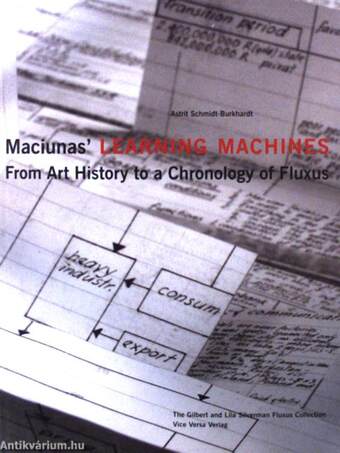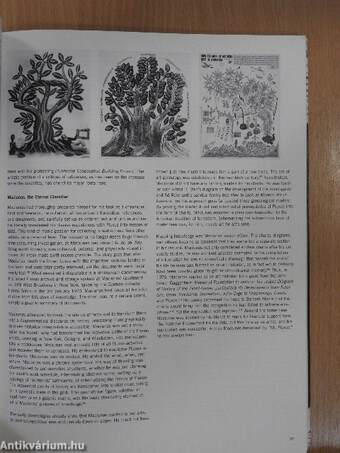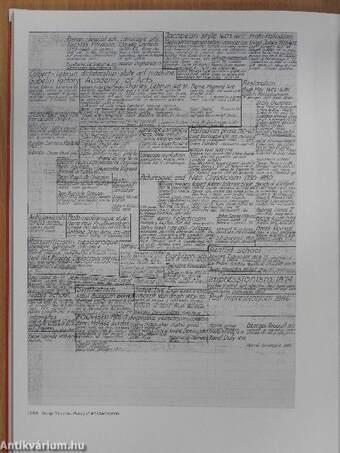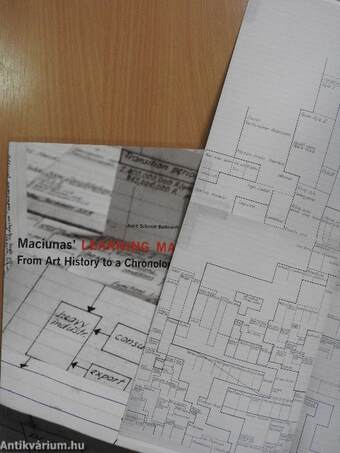1.073.127
kiadvánnyal nyújtjuk Magyarország legnagyobb antikvár könyv-kínálatát

VISSZA
A TETEJÉRE
JAVASLATOKÉszre-
vételek
Maciunas' Learning Machines
From Art History to a Chronology of Fluxus
| Kiadó: | The Gilbert and Lila Silverman Fluxus Collection-Vice Versa Verlag |
|---|---|
| Kiadás helye: | Detroit |
| Kiadás éve: | |
| Kötés típusa: | Fűzött papírkötés |
| Oldalszám: | 127 oldal |
| Sorozatcím: | |
| Kötetszám: | |
| Nyelv: | Angol |
| Méret: | 32 cm x 24 cm |
| ISBN: | 3-932809-39-4 |
| Megjegyzés: | Fekete-fehér kéziratokkal, reprodukciókkal. Két kivehető melléklettel. |
naponta értesítjük a beérkező friss
kiadványokról
naponta értesítjük a beérkező friss
kiadványokról
Fülszöveg
The art of networked thought involves simplifying complexity and creating openings for new ideas. This way of thinking, which remains constant in all spheres of knowledge, aiso defines artistic practice. This book focuses around three dozen diagrams of history, designed by the Fluxus initiator George Maciunas, between 1953 and 1973, as a visualization of chronological causality. If everything developed according to Maciunas' theory, there would not be any real understanding of the evolution of art without charts. His graphic charts, a third of which is being presented to the public for the first time, attempt in various ways to draw a picture of history which is assembled using dates and facts, lines, and vectors. The result appears to be scientific and is at the same time artistically fascinating. It not only provides insight into formerly unknown relationships between dates and historical events; entirely new kinds of knowledge transfer are alsó produced. The diagram as a system... TovábbFülszöveg
The art of networked thought involves simplifying complexity and creating openings for new ideas. This way of thinking, which remains constant in all spheres of knowledge, aiso defines artistic practice. This book focuses around three dozen diagrams of history, designed by the Fluxus initiator George Maciunas, between 1953 and 1973, as a visualization of chronological causality. If everything developed according to Maciunas' theory, there would not be any real understanding of the evolution of art without charts. His graphic charts, a third of which is being presented to the public for the first time, attempt in various ways to draw a picture of history which is assembled using dates and facts, lines, and vectors. The result appears to be scientific and is at the same time artistically fascinating. It not only provides insight into formerly unknown relationships between dates and historical events; entirely new kinds of knowledge transfer are alsó produced. The diagram as a system of order helps us in our contemplation and explanation of the past. A network of tightly interwoven political, cultural-historical, economic, poetic, and aesthetic elements produces a wealth of manifold associations and allusions. Maciunas' charts can be read like a cultural timetable, which alsó outlines the conditions of the Fluxus movement. His universal history serves as a model for the Fluxus chronology which then itself calls for universal significance. On the basis of Maciunas' maps, it is possible to come up with a dynamic definition of those who belong to the hardcore of Fluxus and those who are seen to be "excluded members." The visual display thus takes on the characteristics of a show trial. In this way, the writing of history and pictorial politics is questioned anew. VisszaTémakörök
- Idegennyelv > Idegennyelvű könyvek > Angol > Művészetek > Művészettörténet, általános
- Művészetek > Művészettörténet általános > Idegen nyelv > Angol
- Művészetek > Művészettörténet általános > Művészettörténet > Külföldi
- Művészetek > Művészettörténet általános > Korszakok, stílusok > XX. század > Avantgard
- Művészetek > Művészettörténet általános > Kiállítások, aukciók, katalógusok > Külföldi
- Művészetek > Művészettörténet általános > Tanulmányok > Nemzetközi > Egyéb
Megvásárolható példányok
Nincs megvásárolható példány
A könyv összes megrendelhető példánya elfogyott. Ha kívánja, előjegyezheti a könyvet, és amint a könyv egy újabb példánya elérhető lesz, értesítjük.















